Without a doubt, some of the most popular figures we have ever released in the Mythic Legions line are our “Templar Knights”. The Templar-style figure was first offered as the Sir Godfrey character in the Mythic Legions 1.5 wave, and we later released a Legion Builder version of the Templar. This figure has since been reissued as an All Star and a Reinforcement. Fans seemingly cannot get enough of our Templars, and we believe that part of the appeal is that this figure’s design ties in directly to real world, historical knights which fans immediately recognize. Of course, the Templars are not the only Legions figures whose creation was informed by real world or cultural influences. In this “Behind the Scenes” article, we will explore some of these influences and the Legions figures that have resulted.
An Interesting Conundrum
Before we dive into specific Legions figures we will highlight in this article, it is worth noting that not every one of our fans likes these “real world connections.”
Mythic Legions (and Cosmic Legions as well) are original properties that do not have an entertainment vehicle behind them. There is no movie or television show, no graphic novel or book series to allow fans to familiarize themselves with the characters and the storylines of this line. Real world connections give many fans something familiar to connect with, and many of them buy one of these figures as their first Legion. It is similar to what we see with our “Power-con debut” releases. Since those characters have a connection to something fans recognize, they often act as a gateway into the line.
On the other side of this, we have heard from fans who feel like real world connections take them out of the fantasy Realm that we have created with Mythoss. Seeing actual historical elements make their way into the line feels “off” to them in some way, especially when displayed alongside goblins and orcs and living skeletons!
Ultimately, our goal whenever we touch upon historical or cultural aspects is to allow them to influence and inspire our creations the same way that other things we love play a role in the products we create. Legions will never be a historically accurate recreation of these real-world knights and warriors, but we do enjoy working those elements into the line when we feel it is appropriate – and if we can be allowed to sing our own praises for a moment, we do think these influences have helped us to create some pretty cool toys! Let’s take a look at some of them.
Templar Knights
Those aforementioned Templar Knights are certainly the most obvious and recognizable example of a real-world influence making their way into Mythic Legions. Part of a Catholic military order, The Templars were made up of both soldiers and non-combatant forces. In fact, the vast majority of this order were non-combatants who handled the financial infrastructure of Christendom for a time. The most recognizable feature of the Templar Knights was undoubtedly their white tunics that featured a large red cross on the front. This iconic design feature is what we used in the creation of our own “Templar Knights”.
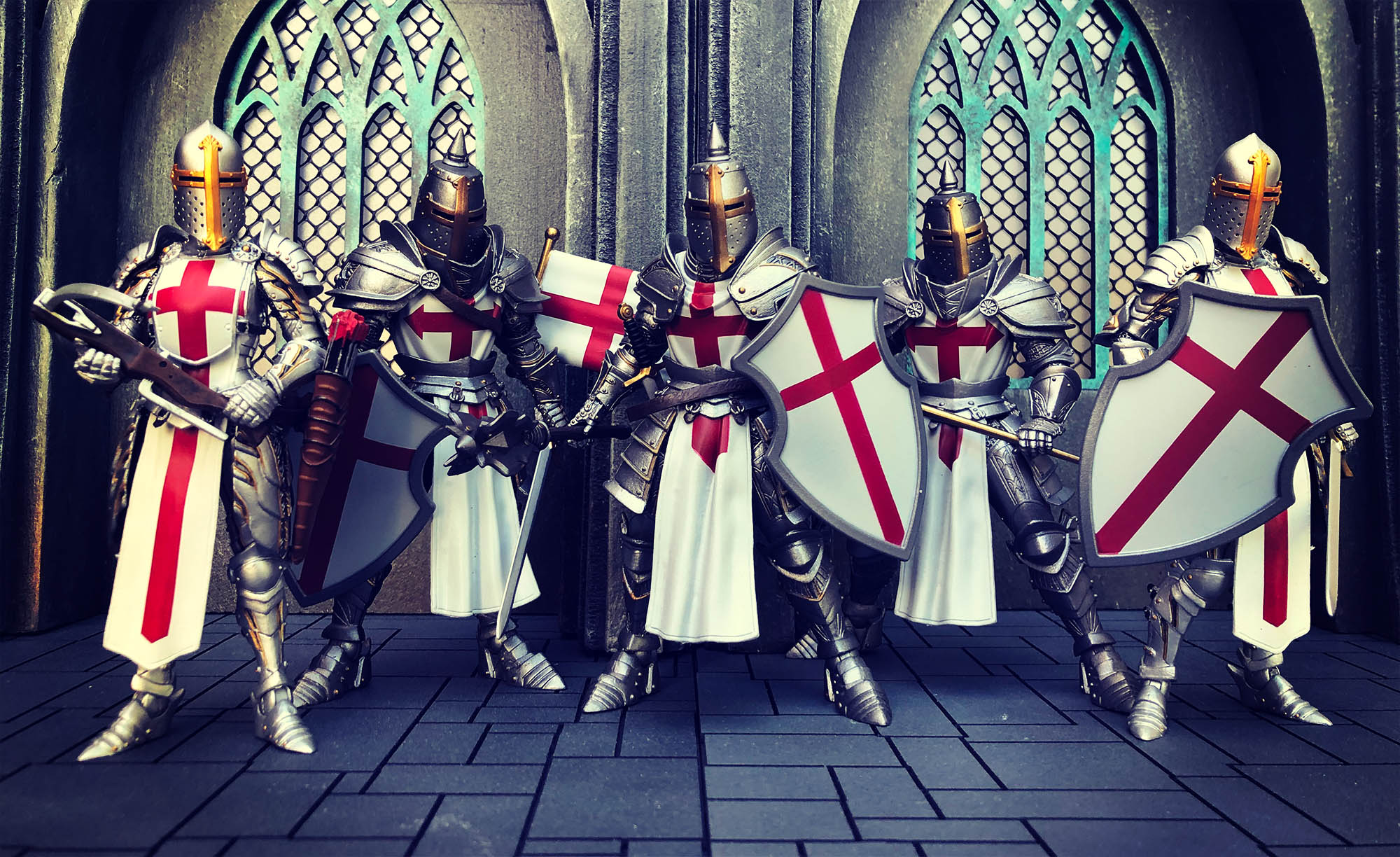
Often confused with the Templar order are the Teutonic Knights and the Knights Hospitaller. The Teutonic Knights wore white tunics with black (instead of red) crosses, while the Hospitallers wore an inverse of this (black tunic with white cross). While all of these orders were Christian in nature, their purposes were certainly different. Templars were charged with protecting Christianity and with finances, the Teutonic Knights were established to protect pilgrims on their treks to the Holy Land, and the Hospitaller established hospitals. We obviously took some liberties with this last order when we created our “Dark Templars”. While we did indeed use the look of the Hospitaller with the black tunic and white cross – we made them a mercenary force operating under the banner of the Sons of the Red Star.
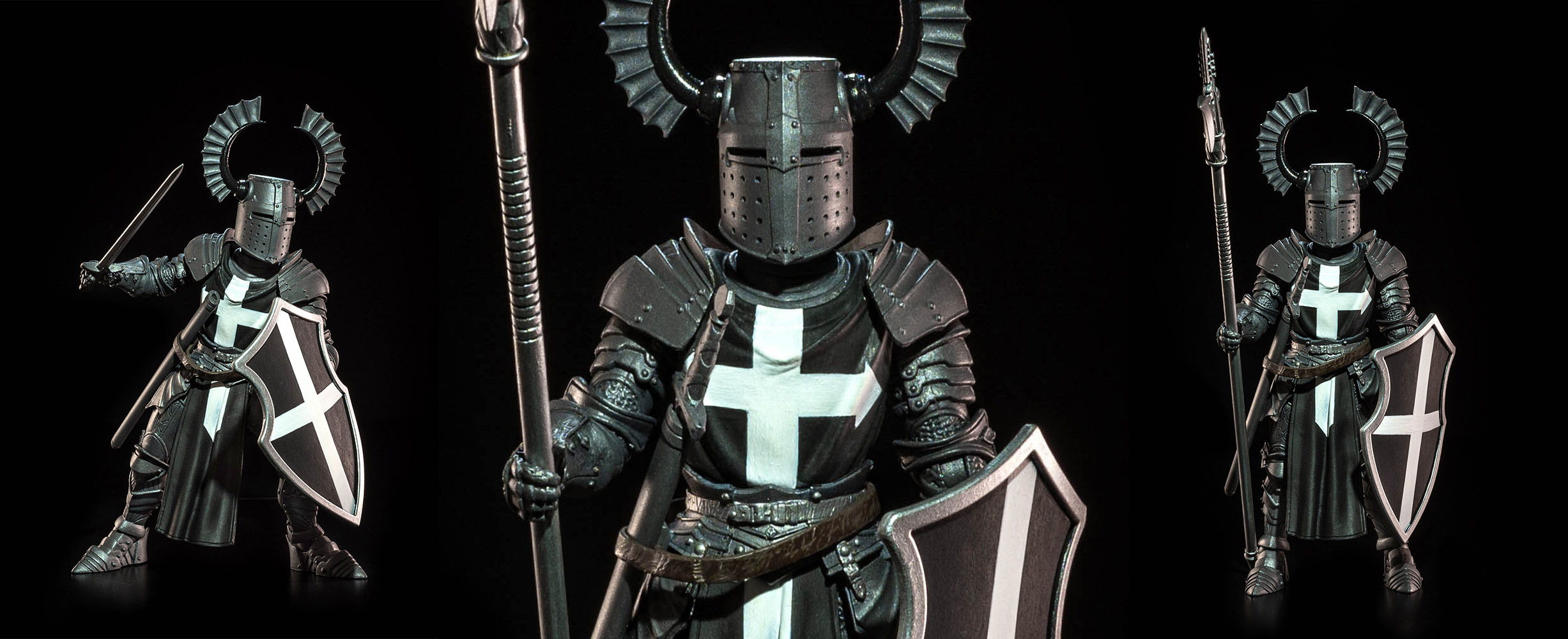
On that same note, and in our biggest departure from historical accuracy when it comes to these knights, we took the look associated with a Templar Sergeant (black tunic with a red cross) and not only made him a member of the Sons of the Red Star, but we also made him a Changeling known as Sir Girard!
Ultimately, these three styles of Legions figures (Templar Knights, Dark Templars, and Sir Girard) are a great example of how we have taken real world influences and altered them to work within the Realm of Mythoss.
Other Knights
Knights have been a staple of Mythic Legions since the beginning, and the Templars are not the only real-world knights who have influenced the line. The look of the knight helmets in our very first wave were based off actual armor, as are many of the weapons that have been seen in the line. The most true-to-life knight armor that has appeared in the line, however, has to be what is seen on the Red Shield Solider.
The entire design of the Red Shield Solider, from the “frog-mouth helm” to the look of the newly sculpted torso, shoulder pauldrons, and waist armor on this figure are based on a specific suit of gothic armor. In fact, when Eric Treadaway sculpted these pieces, his goal was not to put a fantasy spin on them, but rather to stay very true to the actual design of this armor. Ultimately, even with this adherence to accuracy, this figure works wonderfully well within the Realm of Mythoss as a member an elite unit of soldiers fighting under the banner of the Army of Leodysseus.
Spartan Soldiers
Another early figure that was immediately popular with fans thanks to its real-world tie-in was our “Mercurian” figures, including our 1.0 release of Vitus. While this figure is certainly not a historically accurate representation of a Spartan warrior, the design of his helmet is clearly influenced by those of the Spartans. Once again, fans of Greek and Roman history, or even of Frank Miller’s classic “300” graphic novel and the subsequent film, found something familiar in the design of Vitus and he became a popular character in that first wave of Mythic Legions.
Since the release of Vitus, we have added more of these Mercurians to the line in the form of Rahmulus and Deltigar. We even created an “undead” member of the Mercurians with the release of Pixxus!
You can read more about the Mercurians and all of these specific characters in their “Races of Mythoss” article.
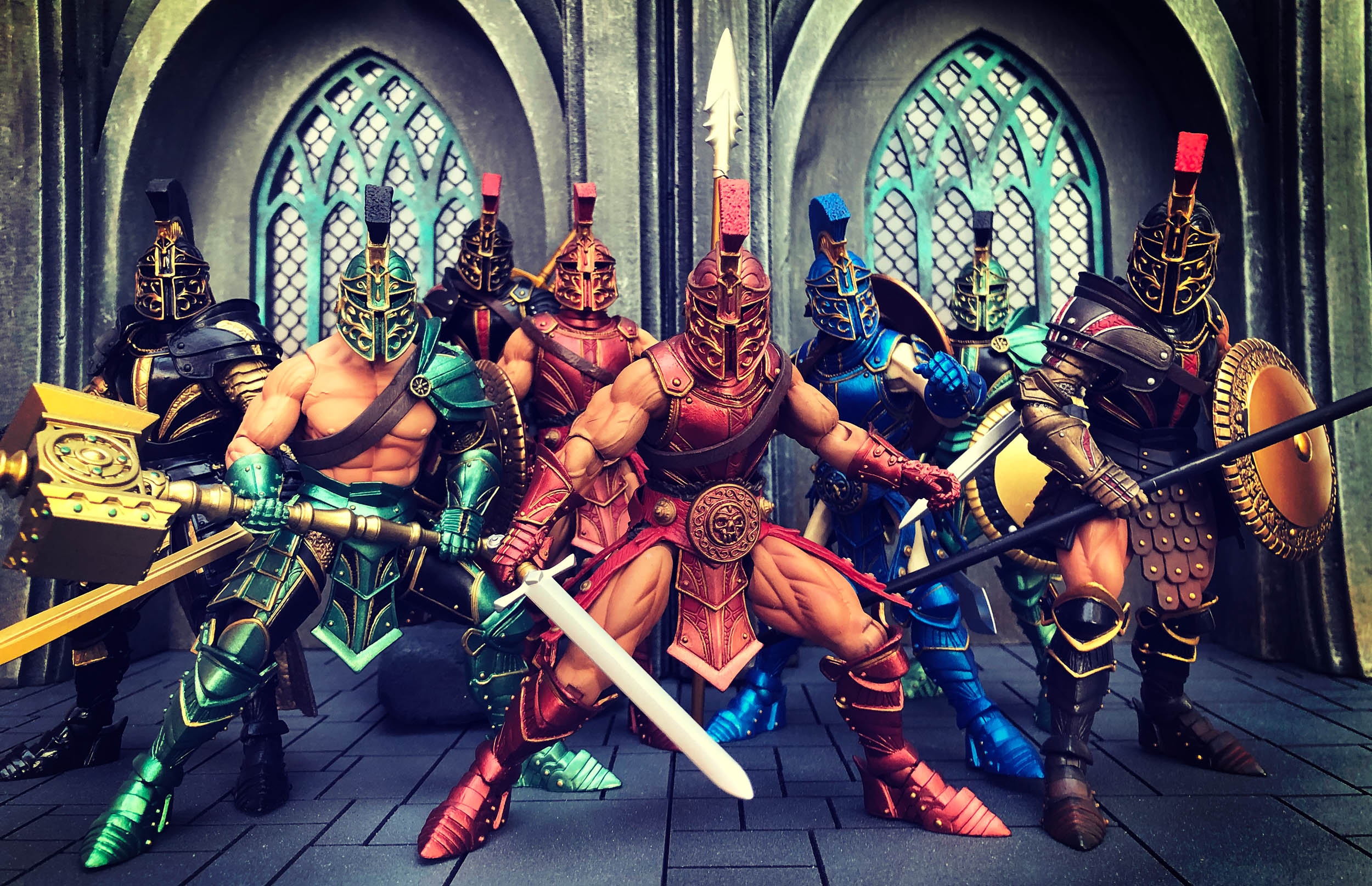
Gladiators
Another historically-influenced figure style that we have featured in a “Races of Mythoss” article are our Gladiator characters. Combatants who fought and died to entertain crowds in ancient Rome, we have taken inspiration from these warriors a number of times in the Mythic Legions line – including an entire release of admittedly fantasy-centric combatants in the “Coliseum” wave.
While you could argue that the aforementioned Mercurians also have a gladiator-like feel to them, the first true gladiator-inspired figure seen in the line was Calavius from the Advent of Decay wave. This figure is very much a Mythic Legions character, yet he uses a helmet that is based on one of the many styles of armor that historical gladiators wore. The same can be said for the gladiator figure found in our Deluxe Legion Builders wave. This figure is also stylized to work well with Legions, and yet there is a touch of authenticity to his design in the form of the helmet he wears.
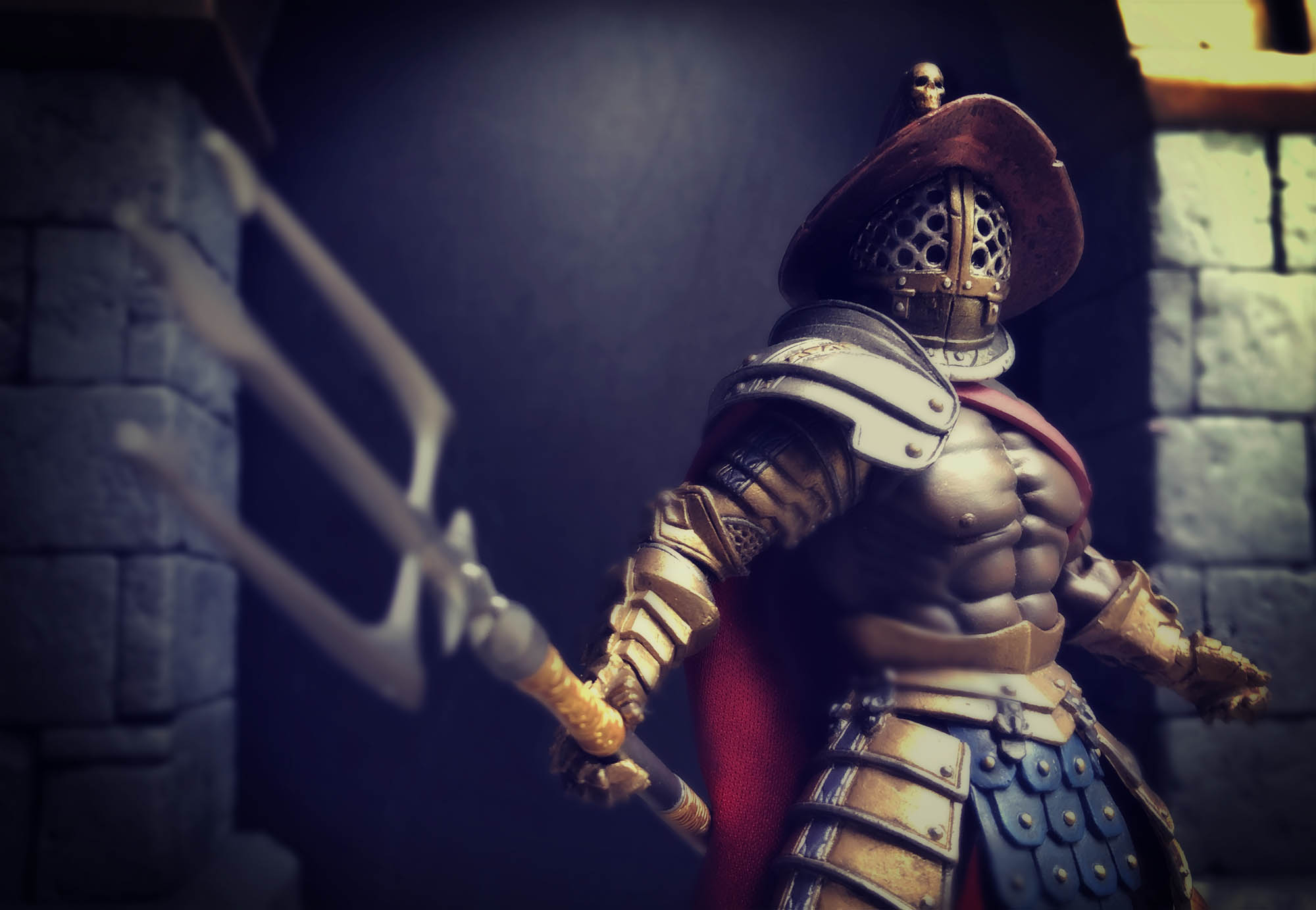
Fantastic Influences
While the Templars, Knights, Mercurians, and Gladiators are all based on actual, historical warriors, Mythic Legions has also mined the more fantastical areas of various cultures for inspiration, including the legends and literature of those culture. One example of this would be our recently revealed Kalizirr figure from the Poxxus wave.
The race known as Djinn or genies can be found in the tales and legends of Arabian mythology, including multiple mentions of these supernatural creatures in the popular “Thousand and One Nights” collection of tales. Elemental beings possessing wonderous powers, there are stories of these magically gifted spirits granting wishes and wielding almost limitless powers. There are also tales of Djinn being bound to objects like golden lamps, and being forced to wield their powers to harsh masters. Many of these aspects of the Djinn obviously influenced the design and storyline presented for Kalizirr. This figure release is another example of a character who has roots in our world – albeit much more fantasy-oriented roots than the Templars or Gladiators.
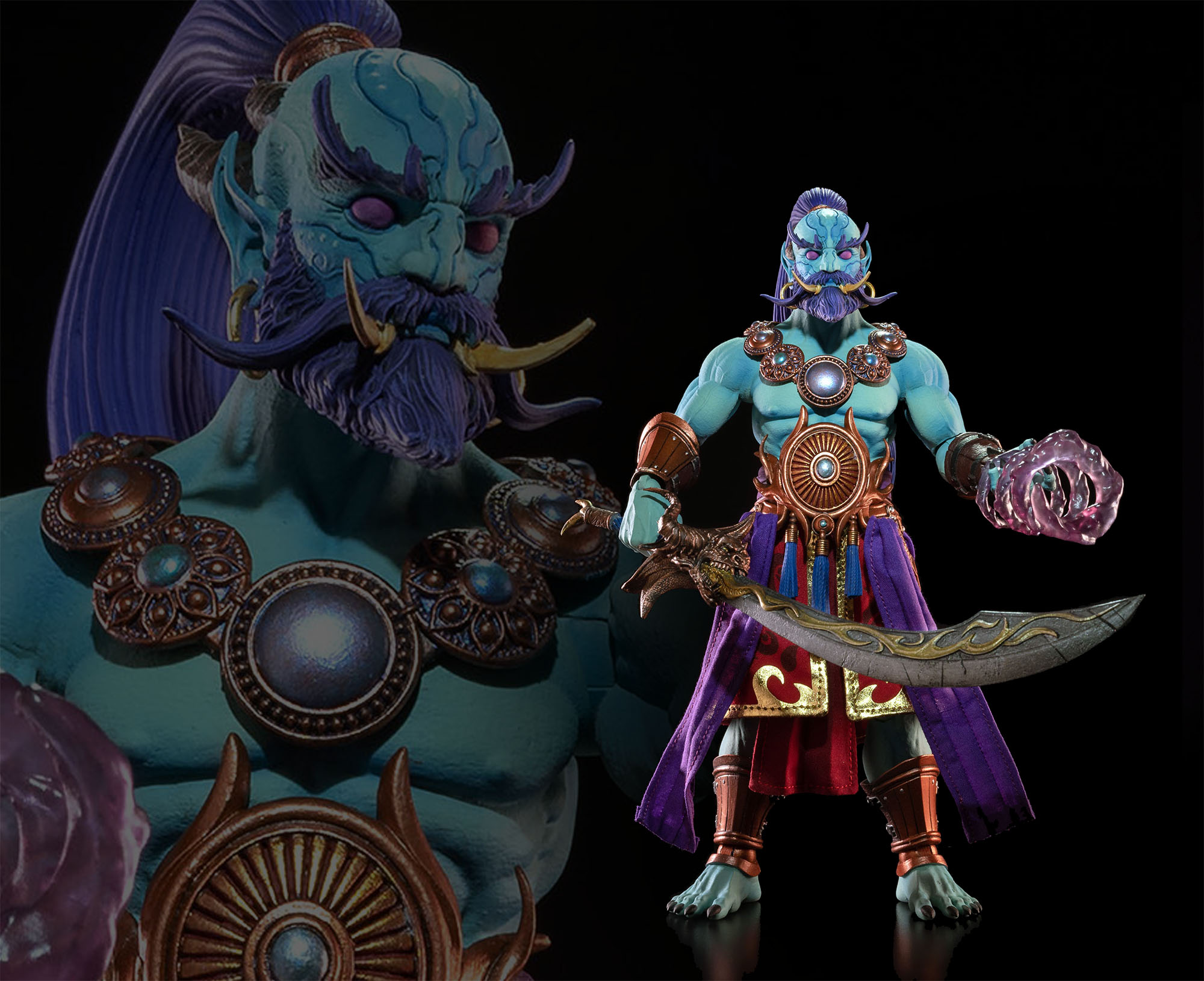
Some of the cultural influences in the line are far less obvious than the examples covered so far in this article. For example, the Jaguallian character of B’alam takes his name from the Mayan language for “Jaguar” and a deity of that same name. There is also the design of the helmet for Gryshaa the Slytherer, which certain feels at home in the Persian culture or even perhaps the domes found atop the Cathedral of Vasily the Blessed, commonly known as Saint Basil’s Cathedral, in Russia. You could even look to some of the design decisions in our barbarian figures or the Ogre-scale Accessory Pack and see influences that are definitely Nordic in nature. All of these are more subtle real-world influences making their way into the Realm of Mythoss and the line of Mythic Legions figures.
Future Historical and Cultural Influence
Whether we are talking about direct historical influences like our Templars or those more subtle nods to our world’s cultures and mythologies, the Mythic Legions line will continue to draw inspiration from real world warriors, mythological monsters, and everywhere in between. While we have heard fans ask for waves that use influences like the samurai of Japan or the pharoahs of Ancient Egypt, we have no plans to do full waves of those types of characters. We may, however, draw upon those cultures and their stories to see how they may one day fit into the Realm of Mythoss.
Published on 02.01.22